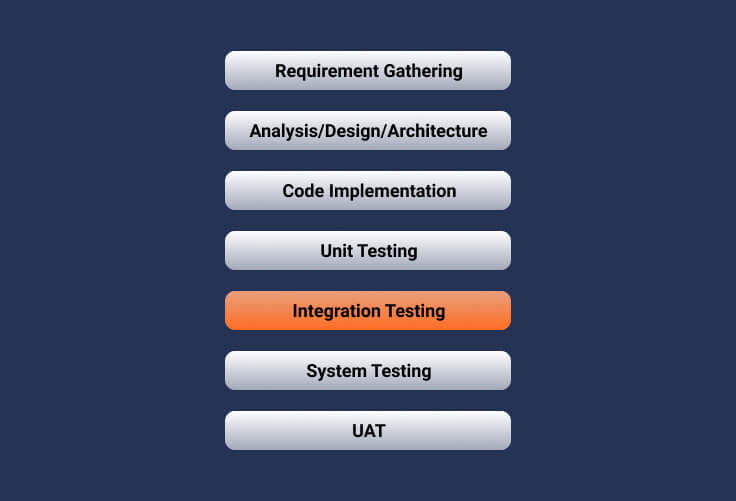What is Integration Testing?
In the hierarchy of software testing of software development, integration testing falls after unit testing. In unit tests, the test subject is tested after being divided into specific units, whereas in integration testing, the individual units are tested in groups. The primary aim of this process is to identify the anomalies when there is interaction amongst these grouped components.
It is also to be noted that different modules are used during the unit tests, while in integrated tests, the modules are put together in combination. The efficiency of these combined modules is tested during the integration test.

Things To Ensure While Performing Integration Testing
- The first functional test is done on every Module, after which Integration Tests is done.
- The sequence has to be maintained while doing integration tests. Hence modules are taken one after the other in proper order.
- It is to be ensured that no integration scenario is missed out in the process.
- The test case strategy is selected, after which test cases that can be executed are made following the data.
- The application is studied, focusing on the structure.
- The essential modules and scenarios are identified.
- The test cases are designed in such a way that in full detail.
- The input data is chosen, which can be used to execute the test cases.
- The developer is to be informed if there are any bugs or defects after the test is conducted.
- Positive and negative tests are done.
Positive Testing
With the help of a positive test, the tester checks if the application does exactly what it is supposed to do.
For example:
In an application, suppose any of the fields asks to enter numeric values between 0-999, while conducting positive test values between 0-999 is to be entered, and that should work as expected.
Negative Testing
With the help of a negative test, the test checks if the application generally works if wrong inputs are inserted. The testing aims to ensure that the system does not stop working if any wrong scenario or incorrect input is fed.
For example:
If the system only accepts numeric values, then the data entered apart from numeric values show through an error message, and the system should not crash.
The above illustration requires boundary value analysis and equivalence partitioning.
While doing positive and negative integration tests, the considerations are:
- Input
- The action
- Output
The different techniques that are used to do positive and negative tests are:
- Boundary value analysis
- Equivalence Partitioning
System Integration Testing
If software testing is done on a combination of hardware and software systems, it is known as a system integration test. The goal of this process is to test how the whole system behaves. It verifies the requirements of both high and low-level software in the Software Design Document and also in the0000 Software Requirements Specification.
It checks whether or not the system can coexist with other software. The interfaces between the modules are tested.
Need for Software Integration Testing
Software Integration Test is done to:
- Detecting the defects earlier.
- Feedback representing whether a module is acceptable or not would be available early.
- The data flow is correct.
- Improved control flow
- Improved timing.
- Better memory usage.
Different Integration Testing Approaches

Big Bang Integration Testing
In Big Bang Testing, all the basic units are clubbed together, and the tests are done at once.
Incremental testing
Here at least two units are integrated, which are logically related and tested together.
Stubs and Drivers
In integration tests, sometimes dummy programs are used like stubs and drivers. If there are modules that are missing, then the stubs and drivers are used as replacements. The Stub is usually known as the Module under Test, and the Driver is known as the Module to be Tested.
Top-Down Integration Testing
As the name suggests, the units on top are tested first and then go down. The top-level modules are tested on priority, and then the lower-level modules.
Bottom-Up Integration Testing
The units at the bottom are tested first and then gradually go up.
Hybrid/Sandwich Integration Testing
It is a combination of top-down and bottom-up integration tests. The three layers present in this approach are:
The primary layer is also known as the target layer.1
- The layer above the target layer.
- The layer below the target layer.
Steps to Perform for Integration Testing
- A test plan is prepared, and interfaces are identified.
- The modules which have to be tested on priority are identified.
- Interfaces are examined.
- The test conditions are demonstrated.
- Test cases, scenarios are designed.
- An automation tool is selected, a script is prepared for the same, and the test cases are executed.
- The tests are repeated to validate until the desired results are not achieved the results.
Integration Testing Tools
The different Integration Testing Tools are:
Protractor
- This is based on Angular and AngularJS. It is an open-source automation framework.
- It is specially used for Integration test
- End-to-end suites can be written with the help of this tool.
- The user’s point of view is considered while running the tests.
Rational Integration Tester
Rational Integration Tester helps to eliminate the bugs that occur during the integration tests. The failure risk decreases to a great extent when this tester is used.
Tessy
Tessy is a software testing tool that is used to do integration tests and unit tests. It helps to find the code coverage of the application. The test cases can be smoothly made with the help of the Classification Tree Editor or CTE.
- The test reports are generated with the help of Tessy.
- C and C + + are supported.
- Code coverage can be used without extra work.
- Test Interface Editor, Test Data Editor, and Workspace are present.
LDRA
Liverpool Data Research Associates or LDRA is used to automate codes and do integration tests. It is also used to check compliance standards. TBrun and LDRAunit are some of the tools under LDRA.
- LDRA is open source.
- TBrun is used in the unit and integration test.
- LDRAUnit is used to create a perfect environment to do the unit tests.
FAQ for Integration Testing
What is Integration Testing?
If software testing is done by performing the tests on a combination of a set of modules, it is known as an integration test. The interactions amongst these different modules are run smoothly or not is watched over through integration test.
What do Integration Tests test?
With the help of the integration test, the data communication amongst the modules is verified. The aim of the tests is to find out how effective the modules are during contact with each other.
When should Integration Testing start?
Integration Test is usually done following Unit Testing. After testing the units, they are clubbed together or integrated to do Integration Testing.
What is Continuous Integration Testing?
In Continuous Integration or CI, there is a repository that is shared by developers for integrated codes. The integrations can be checked with the help of automated tests.
Who is responsible for System Integration Testing?
System Integration Testing, or SIT, is done by both testers and developers.









